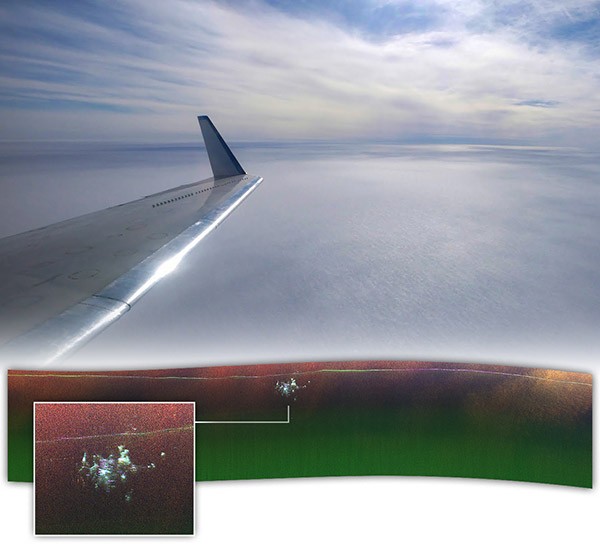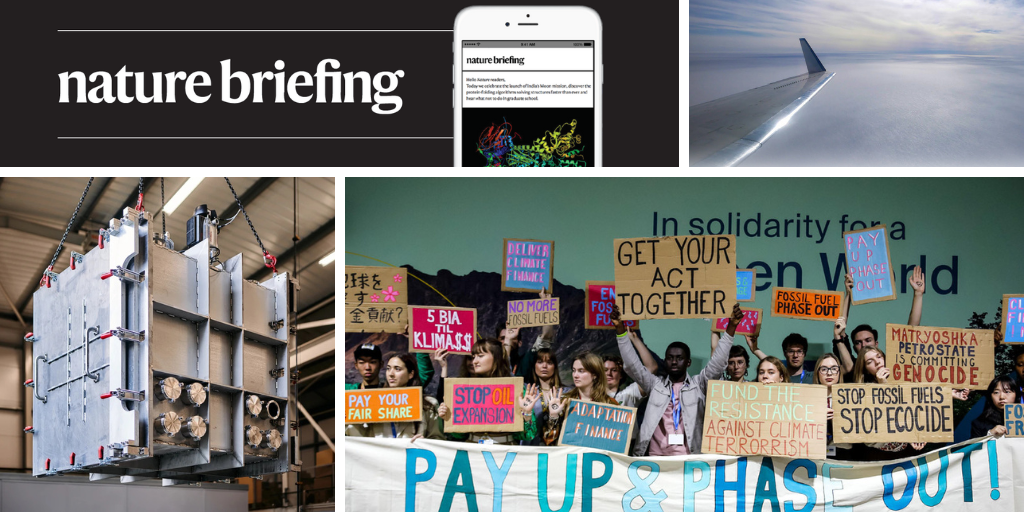Hello Nature readers, would you like to get this Briefing in your inbox free every day? Sign up here.
The NASA Gulfstream III aircraft used radar instruments to map the depth of Greenland’s ice sheet, stumbling on the Camp Century (indicated in the bottom left-hand box) in the process. The depth of the ice bed is indicated by the green line above the base in the main image. (NASA Earth Observatory images by Michala Garrison and Jesse Allen, using UAVSAR data and imagery provided by Chad Greene (NASA/JPL-Caltech) and IceBridge UHF ice-penetrating radar data provided by Joseph MacGregor (NASA/GSFC))
Radar images from a NASA scientific flight over the Greenland ice sheet reveal an unprecedented view of Camp Century, a hidden US Cold War-era military base. The base was built as part of ‘Project Iceworm’, which planned to carve 4,000 kilometres of tunnels into the ice sheet to harbour mobile nuclear-missile launchers. The remnants of the facility are now buried by at least 30 metres of snow and ice. “In the new data, individual structures in the secret city are visible in a way that they’ve never been seen before,” says cryospheric scientist Chad Greene, who co-led the project.
A last-minute deal at the fractious 29th UN climate conference (COP29) in Baku “exposed old wounds between wealthier and poorer nations”, says The Nature Conservancy’s Clare Shakya. Rich countries promised to ‘take the lead’ in increasing climate finance to poor countries to at least US$300 billion annually by 2035. But they did not agree on how much of that will be grants versus loans, nor how much will come from private or public-sector sources. A sketchy pledge is better than none at all, says climate finance researcher Romain Weikmans — especially with a Trump administration on the horizon. “The current level of climate finance ambition has broadly been preserved,” he says. “There is no regression, which was a real risk.”
The Japan Aerospace Exploration Agency (JAXA) aborted an engine test for its Epsilon S rocket after one of its motors exploded. Epsilon project manager Takayuki Imoto said it might take several months to determine the cause of the explosion and take countermeasures, possibly delaying the spacecraft’s scheduled maiden voyage on 31 March 2025. A previous engine test of the rocket failed in July 2023 due to thermal damage to its ignition systems.
Features & opinion
By the end of 2027, researchers at the private quantum-computing firm PsiQuantum aim to be using light in silicon chips to build a giant, programmable quantum computer. That ambitious goal is far ahead of major rivals such as Google and IBM. PsiQuantum researchers say they hope to also show that such a computer can run commercially useful programmes. The company has raised US$1 billion but has shown relatively little compared to its competitors, leaving some scientists worried it’s promising more than it can deliver.
Scientists and students in Russia are struggling to develop their careers abroad in the wake of the country’s invasion of Ukraine. While recognizing that researchers in Ukraine have it far worse, some say their job applications have been rejected by institutions in Europe because of their nationality. Others have been accepted to institutions in the United States but haven’t been able to get a visa. “Everyone realizes the invasion was a tragedy for Ukraine and for science,” says Alexander Kabanov, a nanomedicine researcher who heads the Russian–American Science Association. “But… individual Russians shouldn’t be blamed.”
The recent devastating floods in Valencia exposed the shortcomings of current flash flood defences, argues atmospheric physicist María Carmen Llasat. Governments must work with researchers and communities to establish regulations around the occupation of flood zones and implement an effective method of warning people of incoming catastrophe so that they have enough time to successfully evacuate. “It’s time to consider flooding events more holistically — working and learning across fields and communities — to ensure that such a disaster doesn’t happen again,” she says.
Do people in certain areas of the world really live unusually long lives? Physician Gianni Pes, demographer Michel Poulain and explorer Dan Buettner pioneered the idea together, travelling the world to identify such ‘blue zones’. Buettner’s subsequent commercialization of the concept spawned books, a face cream and a Netflix documentary, but critics remain skeptical that blue zones exist, arguing that poor record keeping and fabricated data plague the field.
Today I’m giggling at the Journal of Universal Rejection — a tongue-in-cheek publication founded by mathematician Caleb Emmons to which “all submissions, regardless of quality, will be rejected”. Why on Earth? Well, you can revel in having “submitted to the most prestigious journal (judged by acceptance rate)”, “without suffering waves of anxiety regarding the eventual fate of your submission”.
Now that the pressure’s off, help ensure that this newsletter keeps getting accepted in your inbox. Please send your feedback to [email protected].
Thanks for reading,
Flora Graham, senior editor, Nature Briefing
With contributions by Jacob Smith
Want more? Sign up to our other free Nature Briefing newsletters:
• Nature Briefing: Careers — insights, advice and award-winning journalism to help you optimize your working life
• Nature Briefing: Microbiology — the most abundant living entities on our planet — microorganisms — and the role they play in health, the environment and food systems
• Nature Briefing: Anthropocene — climate change, biodiversity, sustainability and geoengineering
• Nature Briefing: AI & Robotics — 100% written by humans, of course
• Nature Briefing: Cancer — a weekly newsletter written with cancer researchers in mind
• Nature Briefing: Translational Research — covers biotechnology, drug discovery and pharma


